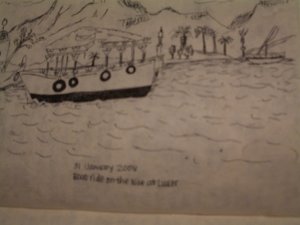On Sunday we joined with thousands of Christian pilgrims in the Palm Sunday procession to Jerusalem.
The procession began at Bethphage, the church marking the spot where Christ mounted the donkey to begin his journey into Jerusalem. There were swarms of Palestinian boys selling palm branches; I bought one for three shekels and joined the rest of the worshipers at the top of the hill. The procession began.
There were people from every country and every walk of life imaginable. I detached myself from the BYU JC crowd to have a more authentic cultural experience. On Palm Sunday, it’s all about the journey.
Along the way, I talked to a woman from Holland who was here with her family. I met two girls my age who were studying conflict resolution at Hebrew University. I walked for a while with a retired couple from Missouri. I walked beside a Polish Catholic group, all dressing in matching uniforms displaying the Polish flag. There were Boy Scout groups from Jericho. There were a few young families there, the daddies carrying their toddlers on their shoulders. There were nuns who had donned baseball caps under their white habits so that their faces wouldn’t get sunburned.
I walked with the processional band, a marching band of sorts, except that it had guitars and hand drums and tambourines. The crowd walked in rhythm and we waved our palm branches in the air, doing our best not to hit anyone in the eye, since the crowd was so thick that we were all elbow to elbow. We sang “Ho-oh-sha-ah-na, ho-oh-sha-ah-na, hoshanna!” There were so many people that the procession reached from the top of the Mount of Olives all the way down into the Kidron Valley.
The singing and celebration continued all the way down into the city through Stephen’s Gate. The band led the crowd into the courtyard of St Anne’s Church; I didn’t know how it was possible to fit that many people into the court, but somehow we all made it.
The festivities didn’t stop at St Anne’s; the band continued to play and everyone danced, including the clergy! The nuns led a line dance, the monks joined in our dance circle, and we all rocked out. My favorite, though, was a Catholic tour group from Spain. Spanish people know how to dance, I tell you what!
After about an hour the merriment had died down, and then the bishop of St Anne’s stood and spoke. He must have translated his speech beforehand, because he read it in Spanish, then Russian, then Arabic, then Hebrew, and finally in English.
He said that we had all come to the Holy Land for different reasons, but we had all come on pilgrimage. He prayed that God would bless Jerusalem with peace. He said that even after we left Jerusalem, it would forever be a part of us. He said that the sacredness of the sites would enter into our souls. He said that it was our responsibility to carry the spirit of Jerusalem to the world. And when he spoke, I knew that his words were true.
So here is my message from Jerusalem, from Palm Sunday:
The Old Testament, the New Testament, the Book of Mormon, and the Doctrine and Covenants all weave together to form a testimony of Jesus Christ. That is because he is the same yesterday, today, and forever. He is the god of the Old Testament. He did come to earth as our Savior.
He does not forget his promises to us. He is the Savior of the entire world: the Jews, the Americans, everyone. He overcame death and sin. He will gather his people again in the last days. Israel will be gathered, and Christ will be our king when he comes again. He will be king over all the earth.

















